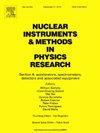Design and initial performance of the beam stop for the first spoke section of the ESS superconducting proton linac
IF 1.4
3区 物理与天体物理
Q3 INSTRUMENTS & INSTRUMENTATION
Nuclear Instruments & Methods in Physics Research Section A-accelerators Spectrometers Detectors and Associated Equipment
Pub Date : 2025-07-22
DOI:10.1016/j.nima.2025.170848
引用次数: 0
Abstract
The design and initial performance of the Insertable Beam Stop (IBS) for the first Spoke (SPK1) section of the ESS superconducting linac are presented. The device was designed, manufactured, tested and installed in order to dump the high-power proton beam of the ESS linac within the first ESS SPK section. The design was optimized and validated via thermomechanical simulations in order to dump [40, 100] MeV protons, proton pulses up to long, repetition rates up to 14 Hz and proton beam current up to 62.5 mA. The volumetric power density was computed to be 35 MW/cm3 maximum after the minimum proton energy. The thermomechanical calculations predicted in the most demanding conditions a peak temperature of around 500 °C in the graphite core and of around 400 °C in the entrance window. Radiation transport calculations were performed with MCNP, CINDER’90 and Attila4MC in order to select materials that minimize the activation of the IBS in the first instance. In particular, for the first time for the ESS linac simulations, Attila4MC and MCNP6 allowed the simulation of the actual CAD models and the calculation of particle fluxes within unstructured meshes, as necessary for the complex linac geometries.
The assembly of the IBS, the acceptance tests, the metrology measurements, the motion tests and the installation were all performed in a cleanroom (class ISO-5). This ensured that no particles were introduced into the vacuum system before the installation of the beam stop in the vicinity of superconducting cavities of the ESS linac. The control system for the operation under vacuum, the motion, the water cooling system, and the monitoring of the temperature on the entrance surface is based on EPICS. The initial performance of the IBS is summarized as it was achievable during the ESS linac commissioning in spring 2025, when it was possible for the first time to perform measurements in the ESS SCL with the probe beam (6 mA, , 1 Hz). In particular for the IBS, the measurements of the temperature with the IBS thermocouples, the vacuum levels in the IBS vessel and the residual gamma dose rates are reported. The simulations, manufacturing, brazing, tests and installation procedures and operational data will be useful for future design of beam-interceptive devices for the ESS superconducting linac.
ESS超导质子直线加速器第一辐段束流停止装置的设计和初始性能
介绍了用于ESS超导直线加速器第一辐段(SPK1)的可插入束流阻器(IBS)的设计和初始性能。该装置的设计、制造、测试和安装是为了将ESS直线加速器的高功率质子束倾倒在ESS SPK的第一个部分。对该设计进行了优化,并通过热力学模拟验证了该设计,以获得[40,100]MeV的质子,长达50μs的质子脉冲,高达14 Hz的重复率和高达62.5 mA的质子束电流。计算出最小质子能量后的体积功率密度最大值为35 MW/cm3。热力学计算预测,在最苛刻的条件下,石墨芯的峰值温度约为500°C,入口窗口的峰值温度约为400°C。使用MCNP、CINDER ' 90和Attila4MC进行辐射输运计算,以便选择能够在第一次将IBS激活最小化的材料。特别是,对于ESS直线模拟,Attila4MC和MCNP6首次允许模拟实际CAD模型并计算非结构化网格内的颗粒通量,这是复杂直线几何形状所必需的。IBS的组装、验收测试、计量测量、运动测试和安装都是在洁净室(ISO-5级)进行的。这确保了在ESS直线加速器超导腔附近安装束流停止装置之前,没有粒子被引入真空系统。真空运行控制系统、运动控制系统、水冷却控制系统以及入口表面温度监控系统均采用EPICS技术。IBS的初始性能是在2025年春季ESS直线加速器调试期间实现的,当时首次有可能在ESS SCL中使用探头光束(6 mA, 5μs, 1 Hz)进行测量。特别是对IBS,用IBS热电偶测量了温度,IBS容器内的真空度和剩余伽马剂量率。模拟、制造、钎焊、测试和安装程序以及运行数据将为ESS超导直线加速器束流拦截装置的未来设计提供有用的数据。
本文章由计算机程序翻译,如有差异,请以英文原文为准。
求助全文
约1分钟内获得全文
求助全文
来源期刊
CiteScore
3.20
自引率
21.40%
发文量
787
审稿时长
1 months
期刊介绍:
Section A of Nuclear Instruments and Methods in Physics Research publishes papers on design, manufacturing and performance of scientific instruments with an emphasis on large scale facilities. This includes the development of particle accelerators, ion sources, beam transport systems and target arrangements as well as the use of secondary phenomena such as synchrotron radiation and free electron lasers. It also includes all types of instrumentation for the detection and spectrometry of radiations from high energy processes and nuclear decays, as well as instrumentation for experiments at nuclear reactors. Specialized electronics for nuclear and other types of spectrometry as well as computerization of measurements and control systems in this area also find their place in the A section.
Theoretical as well as experimental papers are accepted.

 求助内容:
求助内容: 应助结果提醒方式:
应助结果提醒方式:


